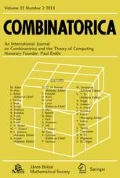Abstract
Many results have been proved on the distribution of the primitive roots. These results reflect certain random type properties of the set G p of the primitive roots modulo p. This fact motivates the question that in what extent behaves G p as a random subset of ℤ p ? First a much more general form of this problem is studied by using the notion of pseudo-randomness of subsets of ℤ n which has been introduced and studied recently by Dartyge and Sárközy. This is followed by the study of the pseudo-randomness of a subset of ℤ p defined by index properties. In both cases it turns out that these subsets possess strong pseudo-random properties (the well-distribution measure and correlation measure of order k are small) but the pseudo-randomness is not perfect: there is a pseudo-random measure (the symmetry measure) which is large.
Similar content being viewed by others
References
R. Ahlswede, C. Mauduit and A. Sárközy: Large families of pseudorandom sequences of k symbols and their complexity, Parts I and II; in: General Theory of Information Transfer and Combinatorics, Lecture Notes in Computer Science 4123, Springer, 2006; pp. 293–307 and 308–325.
D. Burgess: On character sums and primitive roots, Proc. London Math. Soc.12 (1962), 179–192.
G. Choi and A. Zaharescu: Additive patterns in a multiplicative group in a finite field, Manuscripta Math.111 (2003), 187–194.
C. Cobeli and A. Zaharescu: On the distribution of primitive roots mod p, Acta Arith.83 (1998), 143–153.
C. Dartyge, E. Mosaki and A. Sárközy: On large families of subsets of the set of the integers not exceeding N, Ramanujan Journal18(2) (2009), 209–229.
C. Dartyge and A. Sárközy: On pseudo-random subsets of the set of the integers not exceeding N, Periodica Math. Hungar.54 (2007), 183–200.
C. Dartyge and A. Sárközy: Large families of pseudorandom subsets formed by power residues, Journal of Uniform Distribution Theory2(2) (2007), 73–88.
C. Dartyge and A. Sárközy: On pseudo-random subsets of ℤn, Monatsh. für Math.157(1) (2009), 13–35.
H. Davenport: On primitive roots in finite fields, Quarterly J. Math.8 (1937), 308–312.
H. Davenport and D. J. Lewis: Character sums and primitive roots in finite fields, Rend. Circ. Matem. Palermo12 (1963), 129–136.
L. Goubin, C. Mauduit and A. Sárközy: Construction of large families of pseudorandom binary sequences, J. Number Theory106 (2004), 56–69.
K. Gyarmati: On a family of pseudo-random binary sequences, Periodica Math. Hungar.49 (2004), 45–63.
K. Gyarmati: On a pseudorandom property of binary sequences, Ramanujan Journal8 (2004), 289–302.
J. Johnsen: On the distribution of powers in finite fields, J. Reine Angew. Math.251 (1971), 10–19.
C. Mauduit and A. Sárközy: On finite pseudorandom binary sequences, I. Measure of pseudorandomness, the Legendre symbol; Acra Arith.82 (1997), 365–377.
A. Sárközy: A finite pseudorandom binary sequence, Studia Sci. Math. Hungar.38 (2001), 377–384.
W. M. Schmidt:Equations over Finite Fields. An Elementary Approach; Lecture Notes in Math. 536, Springer, New York, 1976.
M. Szalay: On the distribution of primitive roots mod p (in Hungarian), Mat. Lapok21 (1970), 357–362.
M. Szalay: On the distribution of the primitive roots of a prime, J. Number Theory7 (1975), 184–188.
E. Vegh: Pairs of consecutive primitive roots modulo a prime, Proc. Amer. Math. Soc.19 (1968), 1169–1170.
E. Vegh: Primitive roots modulo a prime as consecutive terms of an arithmetic progression, J. Reine Angew. Math.235 (1969), 185–188.
E. Vegh: A note on the distribution of primitive roots of a prime, J. Number Theory3 (1971), 13–18.
A. Weil: Sur les courbes algébriques et les variétés qui s’en déduisent, Act. Sci. Ind.1041 = Publ. Inst. Math. Univ. Strasbourg7 (1945), Hermann, Paris, (1948).
Author information
Authors and Affiliations
Corresponding author
Additional information
Research partially supported by the Hungarian National Foundation for Scientific Research, Grant no. K 67676, K 72731 and by French-Hungarian exchange program Balaton No. F-48/2006.
Research partially supported by the Hungarian National Foundation for Scientific Research, Grant no. K 67676 and by French-Hungarian exchange program Balaton No. F-48/2006.
Rights and permissions
About this article
Cite this article
Dartyge, C., Sárközy, A. & Szalay, M. On the pseudo-randomness of subsets related to primitive roots. Combinatorica 30, 139–162 (2010). https://doi.org/10.1007/s00493-010-2534-y
Received:
Published:
Issue Date:
DOI: https://doi.org/10.1007/s00493-010-2534-y



